The DAX 30 index
In this article, Nithisha CHALLA (ESSEC Business School, Grande Ecole Program – Master in Management, 2021-2023) presents the DAX 30 index and details its characteristics.
The DAX 30 index
The largest and most liquid 30 publicly traded German companies are represented by the DAX 30 index. This index was established by the Frankfurt Stock Exchange on July 1, 1988. “Deutscher Aktienindex” or the German stock index in English, is abbreviated as DAX. Deutsche Boerse AG, which also runs the Frankfurt Stock Exchange, is in charge of managing the DAX 30.
The choice of the companies for the DAX index is based on a number of variables, such as trading volume, market capitalization, and liquidity. The Deutsche Boerse Index Commission regularly modifies and reviews the index’s composition, ensuring that DAX 30 accurately captures the overall performance of the German stock market.
The DAX 30 is a free float market capitalization-weighted index, which means that each company’s weight in the index is based on the calculation of its market capitalization. The performance of the German stock market is measured against the DAX 30, which is closely monitored by traders and investors worldwide. Investors and traders wishing to follow the performance of the German stock market can easily access the index as it is published and distributed in real-time by several financial news sources.
The ticker symbol “DAX” is used in trading platforms and financial websites to identify the DAX 30.
Table 1 below gives the Top 10 stocks in the DAX 30 index in terms of market capitalization as of January 31, 2023.
Table 1. Top 10 stocks in the DAX 30 index.

Source: computation by the author (data: Yahoo! Finance website).
Calculation of the DAX 30 index value
The performance of the 30 largest and busiest German companies listed on Frankfurt Stock Exchange is reflected in the DAX 30, a blue-chip stock market index. A free-float market-capitalization-weighted methodology is utilized to calculate the index, which means that each company’s weight in the index is determined by its market capitalization adjusted for the shares that are actually traded in the secondary market (float).
The formula to compute the DAX 30 index is given by
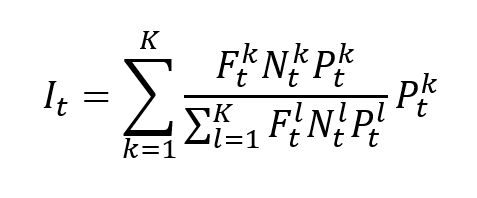
where I is the index value, k a given asset, K the number of assets in the index, Pk the market price of asset k, Nk the number of issued shares for asset k, Fk the float factor of asset k, and t the time of calculation of the index.
In a float-adjusted market-capitalization-weighted index, the weight of asset k is given by formula
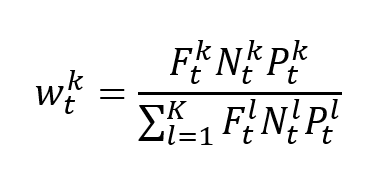
Use of the DAX 30 index in asset management
Investors can examine the sector weightings and geographic exposure of the index to gain insights into performance of the German economy to identify potential opportunities and risks in particular industries or regions. Asset managers compare performance of their equity portfolios to the performance of the complete market using the DAX 30 as the benchmark. Multiple investment products, including exchange-traded funds (ETFs), options, and futures contracts, all have the index as the starting point.
Benchmark for equity funds
One of the highly significant indices in Europe, the DAX 30 serves as standard for the overall performance of German stock market. The businesses represent numerous industries, including those in the automotive, financial, healthcare, technology, and retail sectors. Asset managers and investors use the DAX 30 as the benchmark to compare performance of their portfolios to that of the market as a whole. It is used as gauge of investor sentiment toward the nation’s businesses and financial markets as well as a barometer for the health of the German economy.
Financial products around the DAX 30 index
There are various financial products available that allow investors to gain exposure to German equity market through the DAX 30 index.
- ETFs are investment funds traded on stock exchanges which are designed to track the performance of an index. Some of the ETFs that track the DAX 30 index include the iShares DAX UCITS and the X Trackers DAX UCITS.
- Index funds are designed to track the performance of the index. Examples of the index funds based on the DAX 30 index include the DWS Deutschland Index Fund and the Allianz DAX Index Fund.
- Futures and options contracts based on the DAX 30 index provide investors with ability to speculate on the future performance of the index. Eurex offers futures and options contracts based on the DAX 30 index.
- Certificates are investment products allowing investors to gain exposure to the DAX 30 index. Commerzbank offers a range of certificates linked to the DAX 30 index, such as the ComStage DAX UCITS ETF.
Overall, these financial products offer investors the ability to diversify their portfolios and gain exposure to German equity market, as well as potentially benefit from the performance of the DAX 30 index.
Historical data for the DAX 30 index
How to get the data?
The DAX 30 index is the most common index used in finance, and historical data for the DAX 30 index can be easily downloaded from the internet.
For example, you can download data for the DAX 30 index from December 30, 1987 on Yahoo! Finance (the Yahoo! code for DAX 30 index is ^GDAXI).
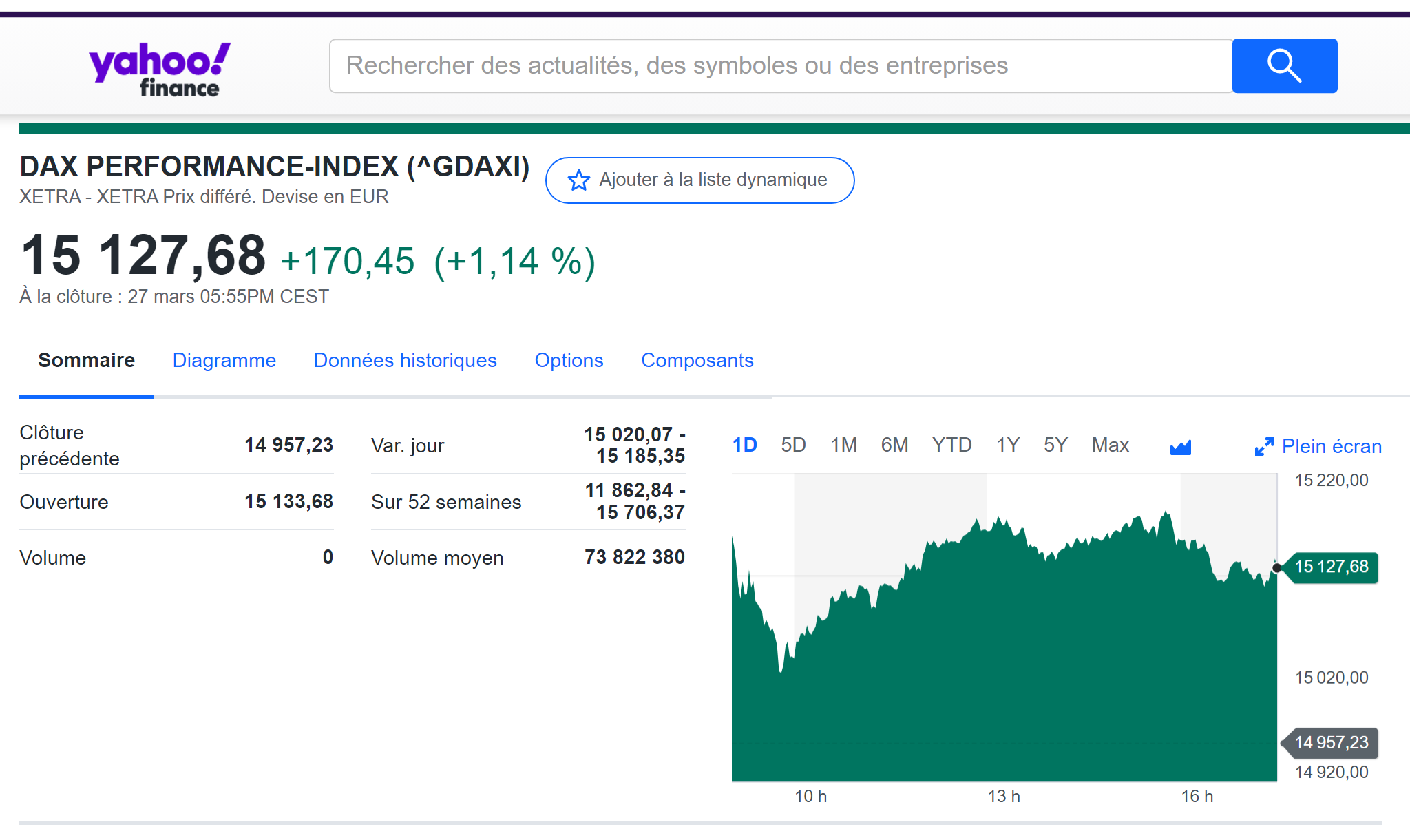
Source: Yahoo! Finance.
You can also download the same data from a Bloomberg terminal.
R program
The R program below written by Shengyu ZHENG allows you to download the data from Yahoo! Finance website and to compute summary statistics and risk measures about the DAX 30 index.
Data file
The R program that you can download above allows you to download the data for the DAX 30 index from the Yahoo! Finance website. The database starts on December 30, 1987. It also computes the returns (logarithmic returns) from closing prices.
Table 3 below represents the top of the data file for the DAX 30 index downloaded from the Yahoo! Finance website with the R program.
Table 3. Top of the data file for the DAX 30 index.
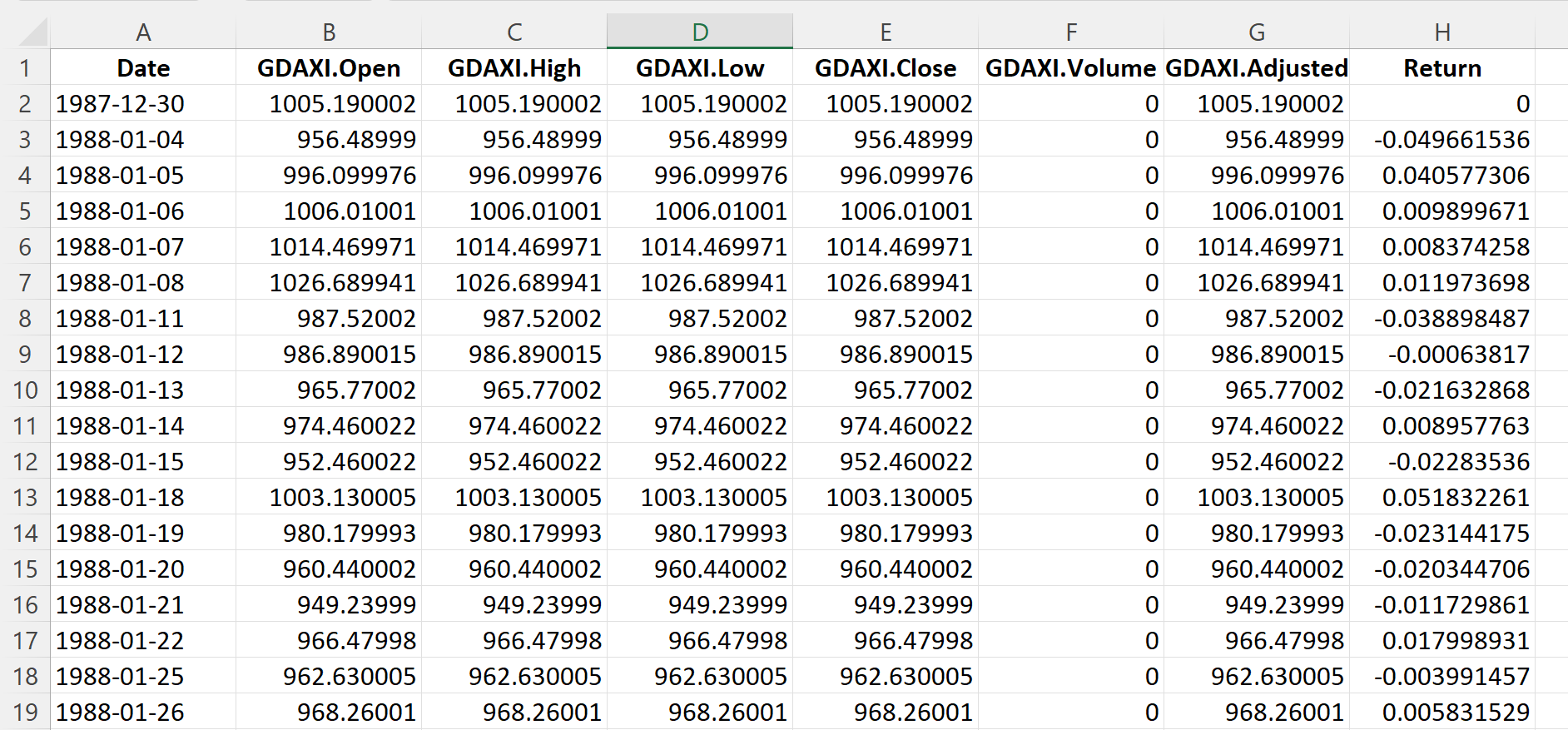
Source: computation by the author (data: Yahoo! Finance website).
Evolution of the DAX 30 index
Figure 1 below gives the evolution of the DAX 30 index from December 30, 1987 to December 30, 2022 on a daily basis.
Figure 1. Evolution of the DAX 30 index.
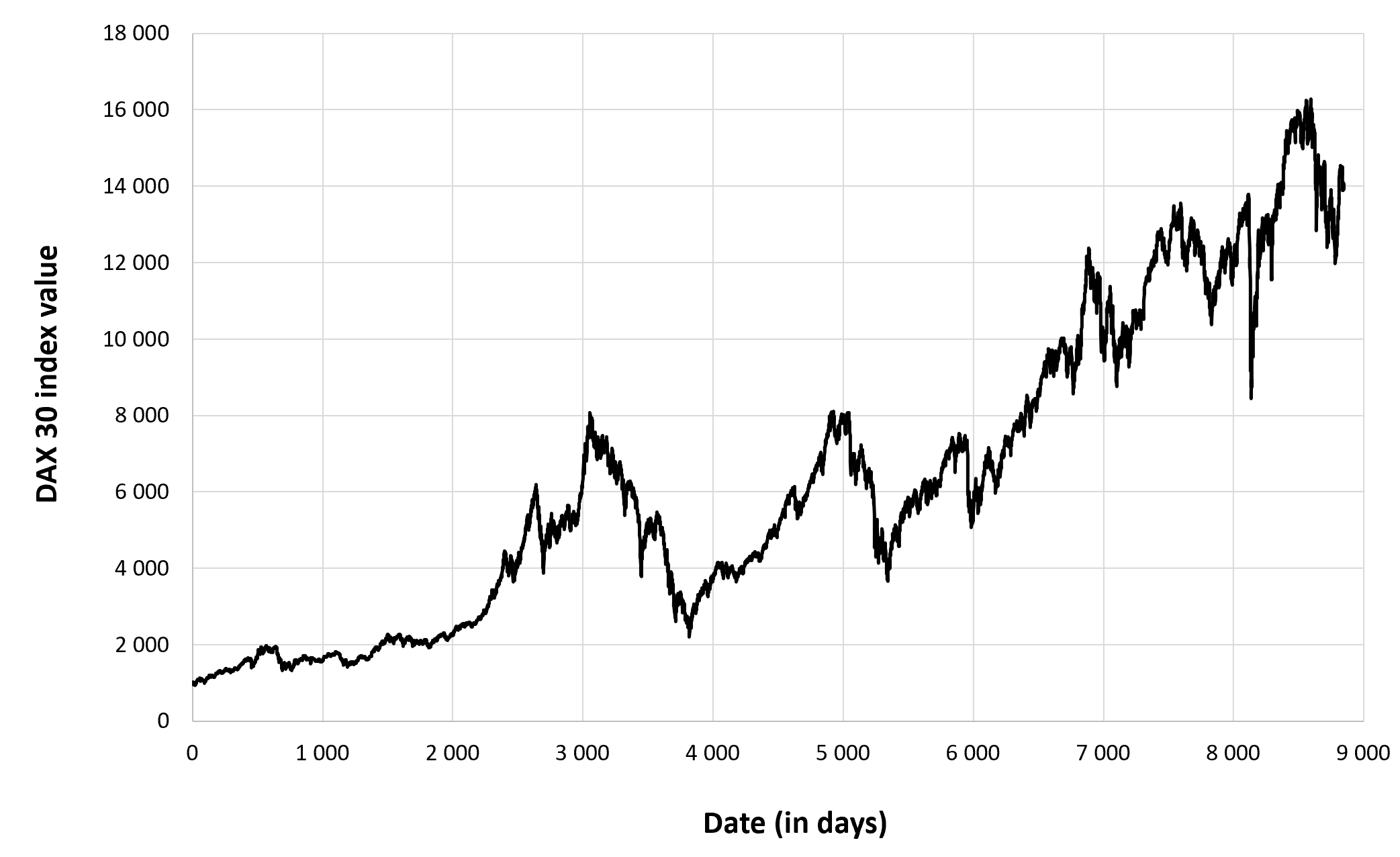
Source: computation by the author (data: Yahoo! Finance website).
Figure 2 below gives the evolution of the DAX 30 index returns from December 30, 1987 to December 30, 2022 on a daily basis.
Figure 2. Evolution of the DAX 30 index returns.
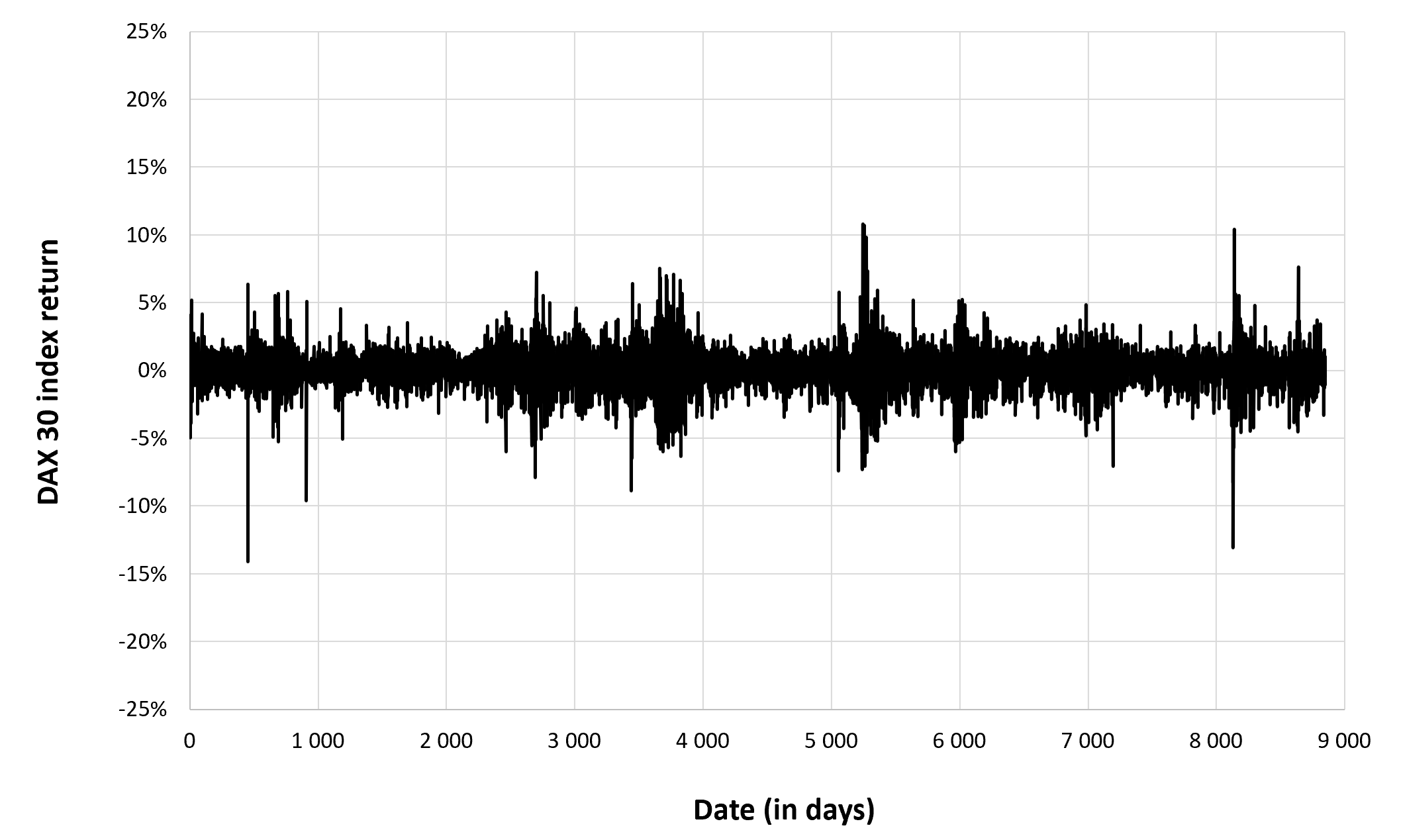
Source: computation by the author (data: Yahoo! Finance website).
Summary statistics for the DAX 30 index
The R program that you can download above also allows you to compute summary statistics about the returns of the DAX 30 index.
Table 4 below presents the following summary statistics estimated for the DAX 30 index:
- The mean
- The standard deviation (the squared root of the variance)
- The skewness
- The kurtosis.
The mean, the standard deviation / variance, the skewness, and the kurtosis refer to the first, second, third and fourth moments of statistical distribution of returns respectively.
Table 4. Summary statistics for the DAX 30 index.
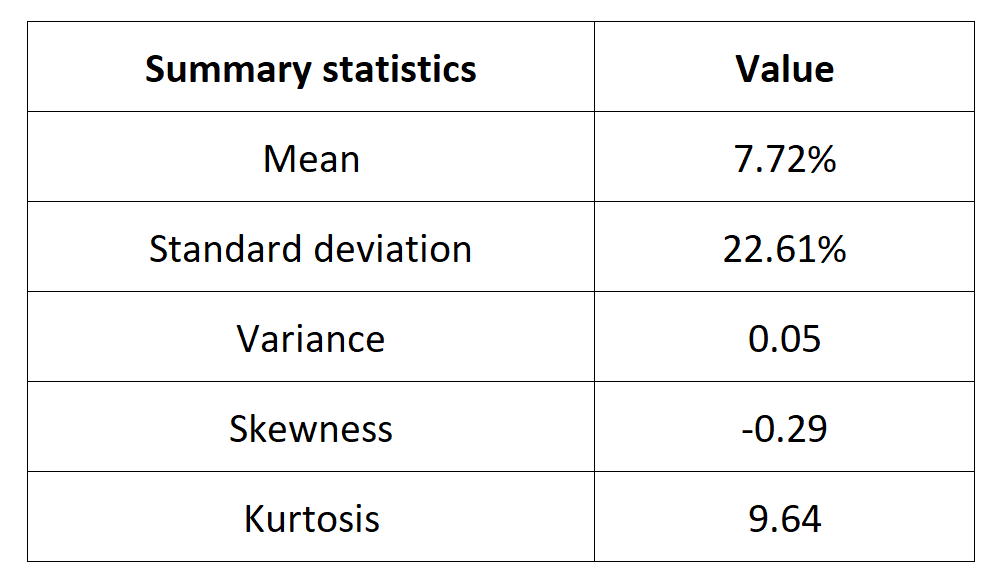
Source: computation by the author (data: Yahoo! Finance website).
Statistical distribution of the DAX 30 index returns
Historical distribution
Figure 3 represents the historical distribution of the DAX 30 index daily returns for the period from December 30, 1987 to December 30, 2022.
Figure 3. Historical distribution of the DAX 30 index returns.
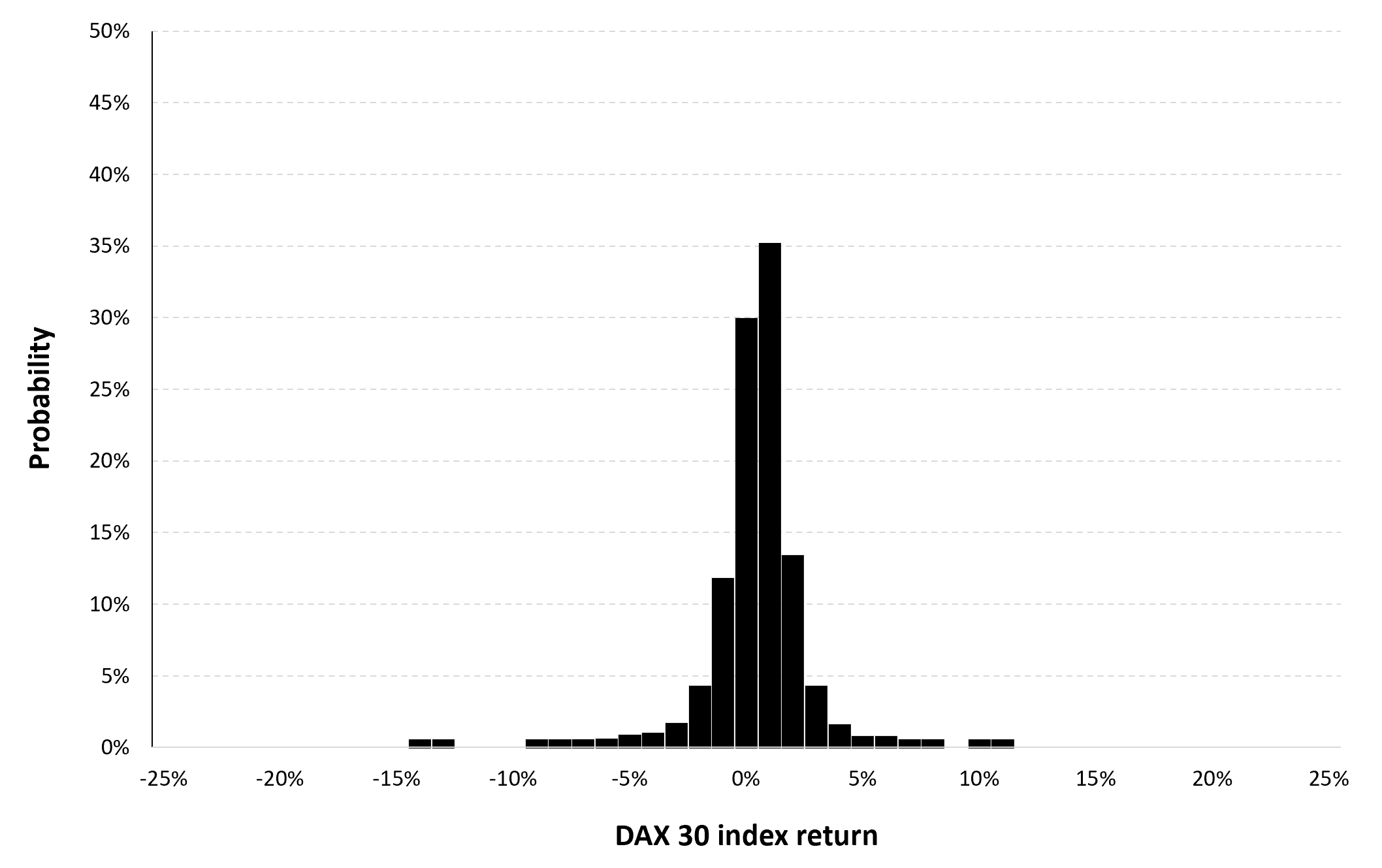
Source: computation by the author (data: Yahoo! Finance website).
Gaussian distribution
The Gaussian distribution (also called the normal distribution) is a parametric distribution with two parameters: the mean and the standard deviation of returns. We estimated these two parameters over the period from December 30, 1987 to December 30, 2022. The mean of daily returns is equal to 0.02% and the standard deviation of daily returns is equal to 1.37% (or equivalently 3.94% for the annual mean and 28.02% for the annual standard deviation as shown in Table 3 above).
Figure 4 below represents the Gaussian distribution of the DAX 30 index daily returns with parameters estimated over the period from v to December 30, 2022.
Figure 4. Gaussian distribution of the DAX 30 index returns.
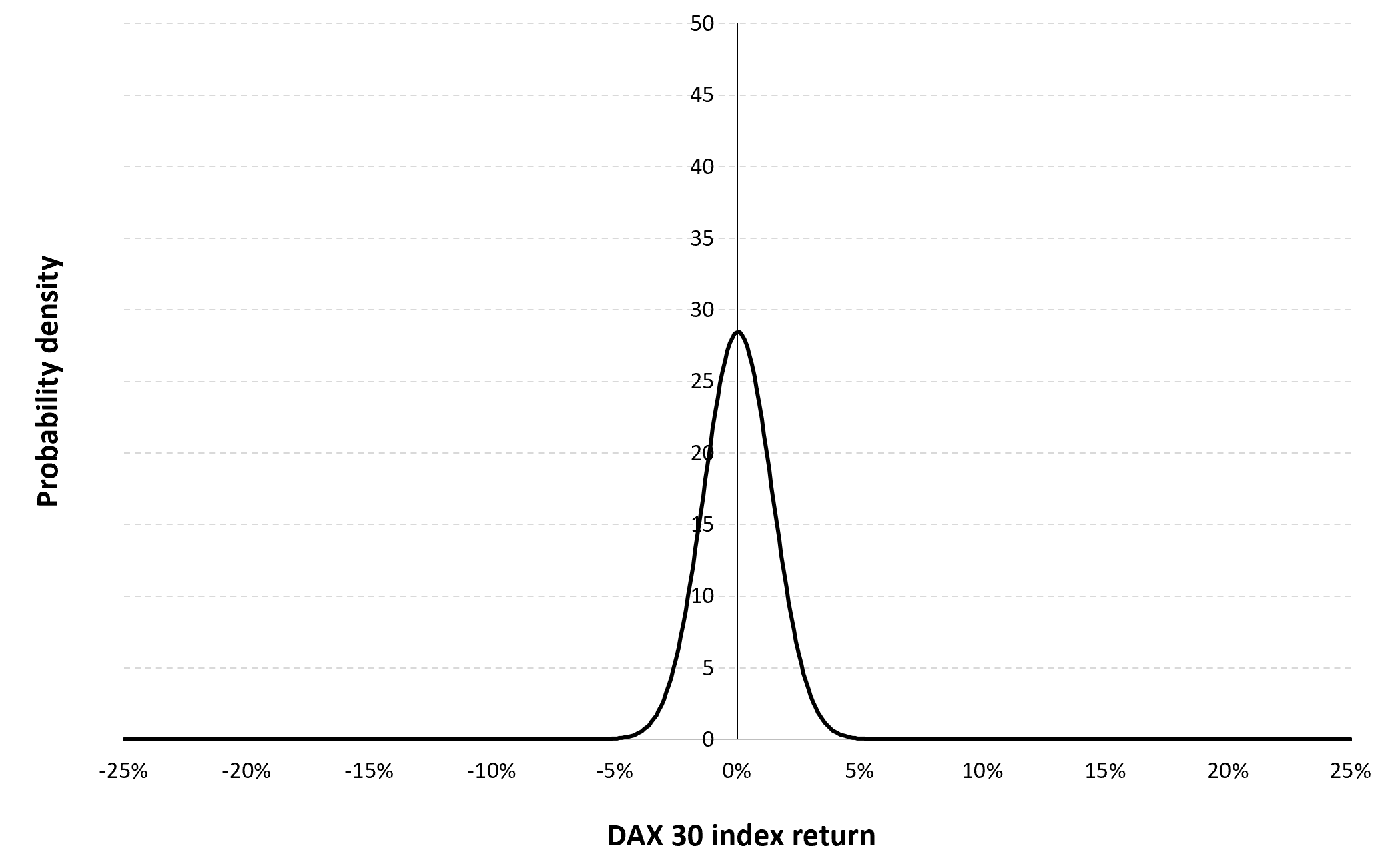
Source: computation by the author (data: Yahoo! Finance website).
Risk measures of the DAX 30 index returns
The R program that you can download above also allows you to compute risk measures about the returns of the DAX 30 index.
Table 5 below presents the following risk measures estimated for the DAX 30 index:
- The long-term volatility (the unconditional standard deviation estimated over the entire period)
- The short-term volatility (the standard deviation estimated over the last three months)
- The Value at Risk (VaR) for the left tail (the 5% quantile of the historical distribution)
- The Value at Risk (VaR) for the right tail (the 95% quantile of the historical distribution)
- The Expected Shortfall (ES) for the left tail (the average loss over the 5% quantile of the historical distribution)
- The Expected Shortfall (ES) for the right tail (the average loss over the 95% quantile of the historical distribution)
- The Stress Value (SV) for the left tail (the 1% quantile of the tail distribution estimated with a Generalized Pareto distribution)
- The Stress Value (SV) for the right tail (the 99% quantile of the tail distribution estimated with a Generalized Pareto distribution)
Table 5. Risk measures for the DAX 30 index.
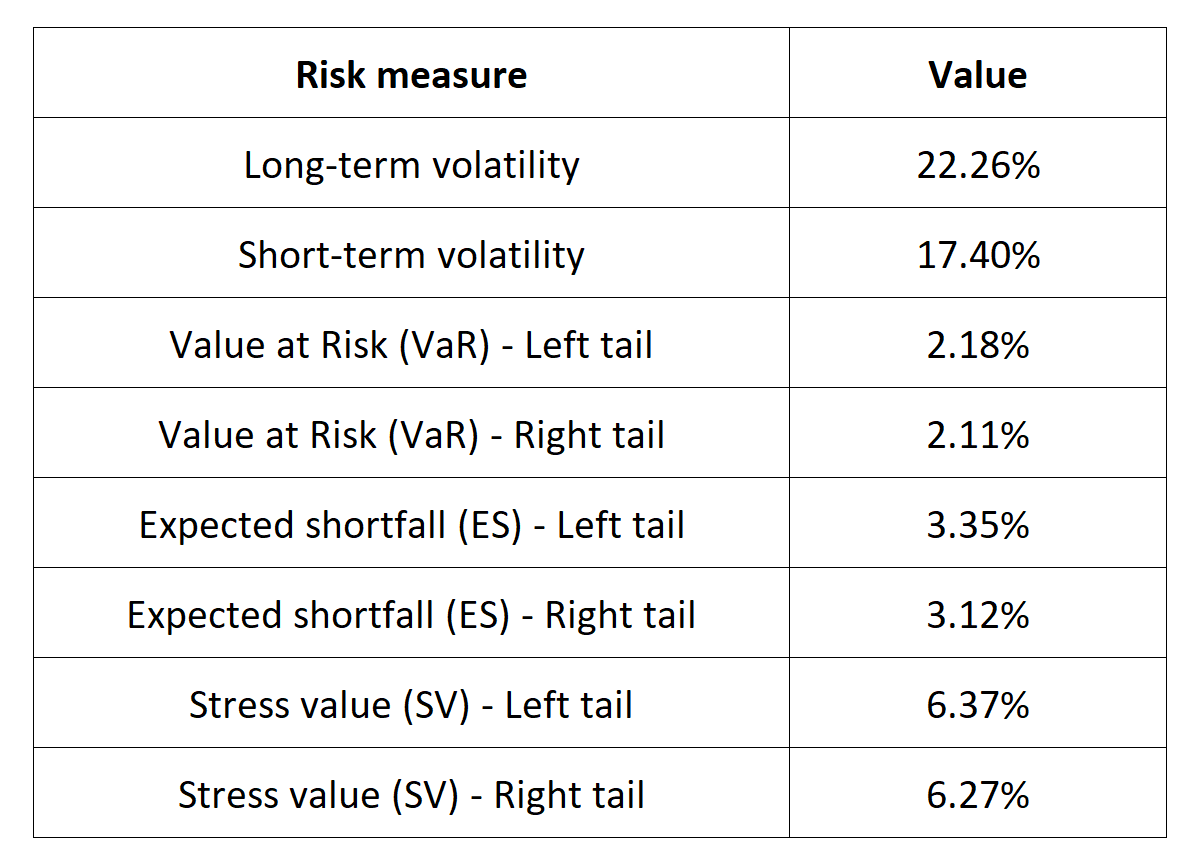
Source: computation by the author (data: Yahoo! Finance website).
The volatility is a global measure of risk as it considers all the returns. The Value at Risk (VaR), Expected Shortfall (ES) and Stress Value (SV) are local measures of risk as they focus on the tails of the distribution. The study of the left tail is relevant for an investor holding a long position in the DAX 30 index while the study of the right tail is relevant for an investor holding a short position in the DAX 30 index.
Why should I be interested in this post?
For a number of reasons, management students (as future managers and individual investors) should learn about the DAX 30 index. The index includes wide range of industries, including energy, finance, telecommunications, and consumer goods, and it covers the biggest and most liquid German companies. Understanding how the index is constructed, how it performs, and the companies that make up the index is important for anyone studying finance or business in Russia or interested in investing in German equities.
Individual investors can assess the performance of their own investments in the German equity market with the DAX 30 index. Last but not least, a lot of asset management firms base their mutual funds and exchange-traded funds (ETFs) on the DAX 30 index which can considered as interesting assets to diversify a portfolio. Learning about these products and their portfolio and risk management applications can be valuable for management students.
Related posts on the SimTrade blog
About financial indexes
▶ Nithisha CHALLA Financial indexes
▶ Nithisha CHALLA Calculation of financial indexes
▶ Nithisha CHALLA The business of financial indexes
▶ Nithisha CHALLA Float
Other financial indexes
▶ Nithisha CHALLA The S&P 500 index
▶ Nithisha CHALLA The FTSE 100 index
▶ Nithisha CHALLA The CAC 40 index
▶ Nithisha CHALLA The CSI 300 index
▶ Nithisha CHALLA The Nikkei 225 index
About portfolio management
▶ Youssef LOURAOUI Portfolio
▶ Jayati WALIA Returns
About statistics
▶ Shengyu ZHENG Moments de la distribution
▶ Shengyu ZHENG Mesures de risques
Useful resources
Academic research about risk
Longin F. (2000) From VaR to stress testing: the extreme value approach Journal of Banking and Finance, N°24, pp 1097-1130.
Longin F. (2016) Extreme events in finance: a handbook of extreme value theory and its applications Wiley Editions.
Business
Wikipedia An introduction to the DAX 30 index
Avatrade Trade the DAX index
Data
Yahoo! Finance Historical data for the DAX 30 index
About the author
The article was written in May 2023 by Nithisha CHALLA (ESSEC Business School, Grande Ecole Program – Master in Management, 2021-2023).


